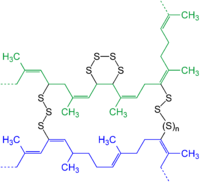
Photo from wikipedia
The radical statistical copolymerization of N–vinyl pyrrolidone (NVP) and 2–chloroethyl vinyl ether (CEVE) was conducted using the Reversible Addition–Fragmentation chain Transfer (RAFT) polymerization technique, employing [(O–ethylxanthyl)methyl]benzene (CTA-1) and O–ethyl S–(phthalimidylmethyl)… Click to show full abstract
The radical statistical copolymerization of N–vinyl pyrrolidone (NVP) and 2–chloroethyl vinyl ether (CEVE) was conducted using the Reversible Addition–Fragmentation chain Transfer (RAFT) polymerization technique, employing [(O–ethylxanthyl)methyl]benzene (CTA-1) and O–ethyl S–(phthalimidylmethyl) xanthate (CTA-2) as the Chain Transfer Agents (CTAs), leading to P(NVP–stat–CEVE) products. After optimizing copolymerization conditions, monomer reactivity ratios were estimated using various linear graphical methods, as well as the COPOINT program, which was applied in the framework of the terminal model. Structural parameters of the copolymers were obtained by calculating the dyad sequence fractions and the monomers’ mean sequence lengths. Thermal properties of the copolymers were studied by Differential Scanning Calorimetry (DSC) and kinetics of their thermal degradation by Thermogravimetric Analysis (TGA) and Differential Thermogravimetry (DTG), applying the isoconversional methodologies of Ozawa–Flynn–Wall (OFW) and Kissinger–Akahira–Sunose (KAS).
Journal Title: Polymers
Year Published: 2023
Link to full text (if available)
Share on Social Media: Sign Up to like & get
recommendations!